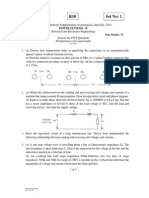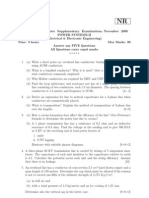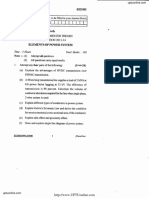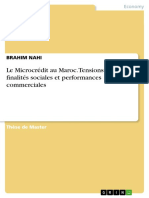ps-II, IImid
ps-II, IImid
Uploaded by
Gopi Pavan JonnadulaCopyright:
Available Formats
ps-II, IImid
ps-II, IImid
Uploaded by
Gopi Pavan JonnadulaOriginal Title
Copyright
Available Formats
Share this document
Did you find this document useful?
Is this content inappropriate?
Copyright:
Available Formats
ps-II, IImid
ps-II, IImid
Uploaded by
Gopi Pavan JonnadulaCopyright:
Available Formats
NRI INSTITUTE OF TECHNOLOGY PS-II / MID-II QUESTIONS / III-I EEE UNIT-5 1. a)What is ferranti effect?
Prove with mathematical expression the actual
phenomenon that occurs in ferranti effect b) A 3-phase, 220 kV, 50 Hz transmission line has equilateral triangular spacing of side 1.5 m. The conductor diameter is 3.0 cm. The air density factor and irregularity factor are 0.95 and 0.8 respectively. Find the disruptive critical voltage and corona loss per km. Assume any data required. [5+5] 2. a) Explain the skin and proximity effects on transmission system b)A 132kV overhead line conductor of radius 1cm is built so that corona takes place if the line voltage is 210 kV (r.m.s). If the value of voltage gradient at which ionization occurs can be taken as 21.21 kV (r.m.s) per cm, determine the spacing between the conductors. [5+5] 3. What are the disadvantages of corona? Explain how the corona considerations affect The design of a line . And what are the factors that effects on corona. [10] 4. a)Determine the disruptive critical voltage and the visual critical voltages for local and General corona on a 3-phase overhead transmission line consisting of three stranded copper conductors spaced at 2.2 meters apart at the corners of an equilateral triangle. Air temperature and pressure are 210C and 73.5 cm of Hg respectively. Conductor diameter is 1.6 cm, irregularity factor (m0) 0.85, and surface factors (mv) 0.7 for local and general corona 0.7 and 0.8 respectively. Breakdown strength of air is 21.1 kV (r.m.s) / cm. b) ) Define disruptive critical voltage and visual critical voltage? On what factor do they depend? Write equations for calculating these voltages. [10]
UNIT-6
1.a)Define string efficiency. Why is it necessary to have high string efficiency? How can it be achieved? b) Each conductor of a 33 kV, 3-phase system is suspended by a string of 3 similar insulators. The capacitance between each insulator pin and earth is 10% of self capacitance of each insulator. Find (i) The distribution of voltage over three insulators and (ii)String efficiency [5+5] 2. a)Explain different types of insulators used in overhead (OH) line? Give their field of application. b) Each of the three insulators forming a string has a self-capacitance of C Farads. The shunting capacitance of the connecting metal work of each insulator is 0.3 C to earth and 0.1 C to the line. A guard ring increases the capacitance to the line of the metal work of the lowest insulator to 0.3 C. Calculate the string efficiency of this arrangement with the guard ring. [5+5] 3. a) Explain why the potential distribution is not, in general, uniform over the string in suspension type of insulators b) Each conductor of a 3-phase high voltage transmission line is suspended from cross arm of steel tower by a string of 4 suspension type disc insulators. If the voltage across the secondunit is 13.2 kV and that across the third unit is 18 kV. Calculate the voltage between the conductors. [3+7] 4. a) A 3-phase 66kV transmission line is carried by strings of 5 suspension insulators. The capacity of each unit insulator to the capacity relative to earth is 4:1. Calculate the potential across each unit and the string efficiency. Assume that there is no leakage. b) derive the expression for voltage distribution over the units of suspension type insulator string. [5+5]
UNIT-7
1. An overhead line consists of 7 strands of copper, having a cross sectional area of 2.0 cm2 Weight of conductor =1.4kg/m, Ultimate strength =8000kg/cm2 Wind pressure =35 kg/m2 of projected area. Calculate the vertical sag of the time for a span of 250 meters, assuming a factor of safety is 5. b) Obtain an expression for sag of a line supported by towers of equal heights at the ends & when the effect of wind & ice are considered. [7+3] 2. a)What is a stringing chart? How can be it is prepared? What is its use b) A transmission line has a span of 160 m between supports, the supports being at the same level. The conductor has a cross-sectional area of 2 cm2. The ultimate strength is 5,000 kg/cm2. The specific gravity of the material is 8.5 gm/cm3. If the coating of ice is 1.0 cm, calculate the sag at the center of the conductor if factor of safety is 4. [3+7] 3. a) What is a sag template? Explain how this is useful for the location of towers and The stringing of power conductors. b) Determine the sag of an overhead line for the following data: span length 150 meters,conductor diameter 0.9 cm, weight per unit length of the conductor 0.65 kg/meter.Ultimate stress 4250 kg/cm2, wind pressure 40 kg/cm2 of projected area and factor of safety 4. [3+7] 4. a) Obtain an expression for sag of a line supported by towers of different heights at the ends b) A transmission line has a span of 50m between level supports. The cross-sectional area of the conductor is 1.25cm2 and weighs 100 kg per 100 meters if the breaking stress is 4220 kg/cm2.Calculate the factor of safety if the sag of the line is 3.5 m.
Assume a maximum wind pressure of 10 kg/m2. [4+6]
UNIT-8
1. a) Derive the formula for insulation resistance of a cable b) The inner and outer diameters of a cable are 3 cm and 7cm. The cable is insulated with two materials having permittivity of 5 and 3 with corresponding stresses of 35kV/cm and 31kV/cm. Calculate the radial thickness of each insulating layer and the safe working voltage of the cable. [3+7] 2. a)Derive a relation between the conductor radius and inside sheath radius of a single Core cable so that the electric stress of the conductor surface may be minimum b) The capacitance of 3-core cable belted type are measured and found to be as follows: (i) Between three cores bunched together and the sheath is 7F (ii) Between the conductor and the other two connected together to the sheath is 4 F. Calculate the capacitance to neutral and the total charging kVA . [3+7] 3. a) Discuss the methods of grading cables. Why are they not used generally? b) A single core 2 km long cable has a conductor radius of 1.3cm and an insulation thickness of 3.5 mm. If the resistivity of dielectric is 7 1012 ohm-m, determine the insulation resistance of the cable. [4+6] 4. a)What do you understand by grading of cable? Explain why grading is more of Theoretical interest than practical? What is the modern practice adopted to avoid grading b)A 3-phase,66 kV, single core cable of conductor diameter 2.5 cm and lead sheath of diameter 6cm and diameters of two inter sheaths are 3cm and 5cm are introduced in-between the core and lead sheath. If the maximum stress in layers is the same.
Find the voltages on the inter sheaths.
[4+6]
You might also like
- Life On Mars Poems by Tracy K Smith 1555975844 PDFDocument5 pagesLife On Mars Poems by Tracy K Smith 1555975844 PDFMonica Montero0% (1)
- It Is Quite Another Electricity: Transmitting by One Wire and Without GroundingFrom EverandIt Is Quite Another Electricity: Transmitting by One Wire and Without GroundingRating: 4.5 out of 5 stars4.5/5 (2)
- r05310203 Power Systems IIDocument8 pagesr05310203 Power Systems IISrinivasa Rao G100% (1)
- Nov 2008Document8 pagesNov 2008Viswa ChaitanyaNo ratings yet
- Power Systems II JNTU PaperDocument8 pagesPower Systems II JNTU PaperShivakrishna MulkaNo ratings yet
- bt3114 Part2 14 11 09rahulDocument38 pagesbt3114 Part2 14 11 09rahulSwathi ChinnuNo ratings yet
- EEE IV SEM - GTD - Module 2 - Probable QuestionsDocument3 pagesEEE IV SEM - GTD - Module 2 - Probable Questionsbharathakumark2001No ratings yet
- PsDocument8 pagesPsAlluri Appa RaoNo ratings yet
- PsiiDocument8 pagesPsiiAlluri Appa RaoNo ratings yet
- Ee335-Transmission and Distribut PDFDocument2 pagesEe335-Transmission and Distribut PDFPradeep AmmasaikuttiNo ratings yet
- T&DDocument5 pagesT&DMATHANKUMAR.SNo ratings yet
- Assignment 1 (Total Marks: 70) EEE 323: Power System IIDocument2 pagesAssignment 1 (Total Marks: 70) EEE 323: Power System IIShahriar SauravNo ratings yet
- Poewr System 2Document4 pagesPoewr System 2కెవి సాయిNo ratings yet
- PS PaperDocument8 pagesPS PaperBhavani Chandra UniqueNo ratings yet
- 07a50202 Powersystems IIDocument8 pages07a50202 Powersystems IIPaone KalyanNo ratings yet
- TD Question BankDocument7 pagesTD Question Bankcitian2008No ratings yet
- 08 r05310203 Power Systems IIDocument8 pages08 r05310203 Power Systems IIandhracollegesNo ratings yet
- 31S11020518 Pdf-MergedDocument2 pages31S11020518 Pdf-MergedrameshNo ratings yet
- MODEL PAPER Ps-1saquibDocument3 pagesMODEL PAPER Ps-1saquibKaize JbNo ratings yet
- Tutorial ProblemsDocument2 pagesTutorial ProblemsIstianaFani33% (3)
- TDP TutDocument3 pagesTDP TutRomil GargNo ratings yet
- EPGTD Assignment 2Document2 pagesEPGTD Assignment 2Harsh GadanNo ratings yet
- rr310203 Power Systems IIDocument8 pagesrr310203 Power Systems IISRINIVASA RAO GANTANo ratings yet
- Rr310203 Power Systems IIDocument8 pagesRr310203 Power Systems IISrinivasa Rao G100% (1)
- 6635 Sept Oct 2020Document6 pages6635 Sept Oct 2020Zing ZuuNo ratings yet
- Fourth Question (Total 15 Marks) 4) Answer The Following QuestionsDocument10 pagesFourth Question (Total 15 Marks) 4) Answer The Following QuestionsRadak RuduNo ratings yet
- Ps-II II MID Question BankDocument3 pagesPs-II II MID Question Banksrinu247No ratings yet
- Model Paper Ps-1saquibDocument3 pagesModel Paper Ps-1saquibStephen BridgesNo ratings yet
- IMP Question Bank For Univwersity Exam - 2023-24Document7 pagesIMP Question Bank For Univwersity Exam - 2023-24ranjitbansoderb7No ratings yet
- nr310203 Power Systems II Set1Document2 pagesnr310203 Power Systems II Set1SRINIVASA RAO GANTANo ratings yet
- PsiiDocument8 pagesPsiiandhracollegesNo ratings yet
- EE3012 Oct2013Document4 pagesEE3012 Oct2013Amazing ElectricalNo ratings yet
- 31R17021119 Pdf-MergedDocument3 pages31R17021119 Pdf-MergedrameshNo ratings yet
- T&D Question Bank Aug 2019Document15 pagesT&D Question Bank Aug 2019thenithyanagrajNo ratings yet
- Home Work Vi Sem Microwave IIDocument12 pagesHome Work Vi Sem Microwave IIGajanan Birajdar100% (1)
- Power System Unit 3 Overhead LinesDocument4 pagesPower System Unit 3 Overhead LinesShrutiNo ratings yet
- WWW - Manaresults.co - In: Code No: R1631021Document2 pagesWWW - Manaresults.co - In: Code No: R1631021MuraliDhar EswaraNo ratings yet
- BDocument7 pagesBrajbir kaurNo ratings yet
- Eee-503 Elements of Power System 2013-14Document3 pagesEee-503 Elements of Power System 2013-14Devesh RaiNo ratings yet
- CH 9Document24 pagesCH 9CaliNo ratings yet
- EE3013 Aug2018Document3 pagesEE3013 Aug2018Amazing ElectricalNo ratings yet
- Unit Test - 2 QuestionsDocument1 pageUnit Test - 2 QuestionsManohar_3020No ratings yet
- Probable Questions - EptdDocument3 pagesProbable Questions - EptdManas ChakrabortyNo ratings yet
- EE301 QB Full Module Previous QPDocument6 pagesEE301 QB Full Module Previous QPMohammed NadheerNo ratings yet
- HVAC & DC AssignDocument3 pagesHVAC & DC Assigndeptai2023No ratings yet
- Instruction Regarding Questions Answer All Questions: National Institute of Technology, RourkelaDocument2 pagesInstruction Regarding Questions Answer All Questions: National Institute of Technology, RourkelaCharandeep TirkeyNo ratings yet
- MCQ EeeDocument9 pagesMCQ EeeVishal ThakurNo ratings yet
- Question Bank On T & DDocument4 pagesQuestion Bank On T & DArpita BanikNo ratings yet
- Unit 3 - Problem Sheet No 3C - CoronaDocument2 pagesUnit 3 - Problem Sheet No 3C - CoronaDeepak Srinivas YadavNo ratings yet
- Https WWW - Suit.edu - PK Uploads Past Papers Power Transmission Distribution - ELC254Document1 pageHttps WWW - Suit.edu - PK Uploads Past Papers Power Transmission Distribution - ELC254GHS Kass Korona MardanNo ratings yet
- Question Bank PS1Document3 pagesQuestion Bank PS1goyal.167009No ratings yet
- PS II - Unit 4Document10 pagesPS II - Unit 4sanjeevgummidi2No ratings yet
- EEN 206 Tut 6Document2 pagesEEN 206 Tut 6anshul240903No ratings yet
- Unit 1 Corona VKM 2023-23-28Document6 pagesUnit 1 Corona VKM 2023-23-28pokkulaanilkumarNo ratings yet
- Module-1 1. 2. 3. 4. 5. 6. 7.: Question BankDocument6 pagesModule-1 1. 2. 3. 4. 5. 6. 7.: Question BankPreethi SinhaNo ratings yet
- Vacuum Nanoelectronic Devices: Novel Electron Sources and ApplicationsFrom EverandVacuum Nanoelectronic Devices: Novel Electron Sources and ApplicationsNo ratings yet
- Simulation of Transport in NanodevicesFrom EverandSimulation of Transport in NanodevicesFrançois TriozonNo ratings yet
- An Essential Guide to Electronic Material Surfaces and InterfacesFrom EverandAn Essential Guide to Electronic Material Surfaces and InterfacesNo ratings yet
- Dwnload Full Statistics For Business Decision Making and Analysis 2nd Edition Stine Solutions Manual PDFDocument36 pagesDwnload Full Statistics For Business Decision Making and Analysis 2nd Edition Stine Solutions Manual PDFwellbornfinikin407k2o100% (21)
- Malefic Planet As Per LagnaDocument6 pagesMalefic Planet As Per Lagnajaiswal.utkarshNo ratings yet
- Vérin de Fosse 300 KG: Siłownik Kanałowi 300 KGDocument16 pagesVérin de Fosse 300 KG: Siłownik Kanałowi 300 KGAlain DefoeNo ratings yet
- Ls 625 Mod 3Document8 pagesLs 625 Mod 3api-650856998No ratings yet
- Facility Management System (FMS)Document14 pagesFacility Management System (FMS)Sarfraz LocusNo ratings yet
- Introduction To CSiBRiDGE - Puente Sección Cajón VariableDocument58 pagesIntroduction To CSiBRiDGE - Puente Sección Cajón VariableRonald Omar García RojasNo ratings yet
- Brochure Furnace Slag enDocument24 pagesBrochure Furnace Slag enSai Sricharan ReddyNo ratings yet
- Usace / Navfac / Afcec / Nasa UFGS-23 64 26 (August 2009) Change 6 - 11/22 - Preparing Activity: NAVFAC Superseding UFGS-23 64 26 (April 2008)Document54 pagesUsace / Navfac / Afcec / Nasa UFGS-23 64 26 (August 2009) Change 6 - 11/22 - Preparing Activity: NAVFAC Superseding UFGS-23 64 26 (April 2008)Ramon De los ReyesNo ratings yet
- Bookeeper Proposal Letter SampleDocument3 pagesBookeeper Proposal Letter SampleEdmark100% (1)
- Passat B5 - Brakes. Technical DataDocument13 pagesPassat B5 - Brakes. Technical DataPedrojzbNo ratings yet
- Multi Cast Configuration Extreme SwitchDocument280 pagesMulti Cast Configuration Extreme SwitchKomunitasGerakanCintaJagapura100% (1)
- 2021-11-06 23.45.15 CrashDocument5 pages2021-11-06 23.45.15 CrashIslam EleziNo ratings yet
- Partha Moulik: HSE Officer at Ashoka Buildcon LimitedDocument3 pagesPartha Moulik: HSE Officer at Ashoka Buildcon LimitedparthaNo ratings yet
- WBJEE 2012 Mathematics Question Paper With SolutionDocument41 pagesWBJEE 2012 Mathematics Question Paper With SolutionPremKumarKalikiri100% (3)
- Spinors and The Dirac EquationDocument19 pagesSpinors and The Dirac EquationandysitobelloNo ratings yet
- A Semi-Detailed Lesson Plan I. Learning OutcomesDocument3 pagesA Semi-Detailed Lesson Plan I. Learning OutcomesDela Cruz, Angelica M.No ratings yet
- Japan Auctions GradesDocument5 pagesJapan Auctions GradesAlzieNo ratings yet
- STR5A464x Series Data Sheet: For Non-Isolated Off-Line PWM Controllers With Integrated Power MOSFETDocument23 pagesSTR5A464x Series Data Sheet: For Non-Isolated Off-Line PWM Controllers With Integrated Power MOSFETHeru susantoNo ratings yet
- Metro Lite SystemDocument14 pagesMetro Lite SystemAPEXA ARYANo ratings yet
- Welcome To The Course On Industrial Automation and ControlDocument25 pagesWelcome To The Course On Industrial Automation and ControlvattuNo ratings yet
- 1000 Ways To Pack The Bin PDFDocument50 pages1000 Ways To Pack The Bin PDFafsarNo ratings yet
- Search Algorithms in Artificial IntelligenceDocument13 pagesSearch Algorithms in Artificial IntelligencenandhiniNo ratings yet
- Politics of Globalisation QP 2019 - TutorialsDuniyaDocument5 pagesPolitics of Globalisation QP 2019 - TutorialsDuniyasatyam kumarNo ratings yet
- Le Microcrédit Au Maroc - Tensions Entre Finalités Sociales Et Performances CommercialesDocument23 pagesLe Microcrédit Au Maroc - Tensions Entre Finalités Sociales Et Performances Commercialesabdhafid meftahiNo ratings yet
- Antisol SDocument4 pagesAntisol Sroni nursetoNo ratings yet
- Connectors 3 1 PDFDocument246 pagesConnectors 3 1 PDFZian HennNo ratings yet
- HDD Hitachi HTS547564A9E384Document170 pagesHDD Hitachi HTS547564A9E384scrib3dsNo ratings yet
- Ge7 Report Formalism ArtDocument15 pagesGe7 Report Formalism Artncl bclsNo ratings yet
- 02 Lembar Jawaban (Filled In)Document21 pages02 Lembar Jawaban (Filled In)Epon NopiantiNo ratings yet

























































































